 | |
| Author | John Nephew |
|---|---|
| Genre | Role-playing game |
| Publisher | TSR |
Publication date | 1989 |
| Pages | 64 |
Tall Tales of the Wee Folk is an accessory for the Dungeons & Dragons fantasy role-playing game.
 | |
| Author | John Nephew |
|---|---|
| Genre | Role-playing game |
| Publisher | TSR |
Publication date | 1989 |
| Pages | 64 |
Tall Tales of the Wee Folk is an accessory for the Dungeons & Dragons fantasy role-playing game.
Tall Tales of the Wee Folk is a supplement that describes magical woodland creatures such as brownies, sprites, dryads, leprechauns, centaurs, pixies, fauns, hsiao, pookas, sidhe, treants, wood imps, and woodrakes, and outlines rules for playing them as player characters (PCs). [1] [2]
Tall Tales of the Wee Folk describes the woodland realm of the Dreamland, which is ruled by the fairy king, Oberon. The Dreamland is home to many creatures drawn from diverse mythological sources, from Celtic sidhe to ancient Greek centaurs and fauns. Other creatures covered include the hsiao (large, intelligent owls) and pookas (shape-changing pranksters). [3] Each of the races is introduced and described by game characters who detail how the races live, what they look like, how they dress, and their cultural outlooks and aspirations; this is followed by game-orientated information that lists experience levels and relevant special abilities. [3] Creatures in PC1 start the game with negative experience points, with balanced relative experience-level costs such that no race is more powerful than another. [3] The adventure book features six short one or two page adventures covering levels 1–26, and a longer fifteen page adventure titled "The Lost Seneschal," which is for 1st-3rd level characters. [3]
PC1 Tall Tales of the Wee Folk was written by John Nephew and published by TSR in 1989 as a sixty-four page book with an outer folder. [1] The package also includes a thirty-two page adventure booklet, and features editing by Gary L. Thomas, a cover illustration by Keith Parkinson, and interior illustrations by Valerie Valusek. [3]
Dave Hughes reviewed Creature Crucible: Tall Tales of the Wee Folk for Games International magazine, and gave it 4 stars out of 5, and stated that "Some of its reference material is fascinating, drawing on Welsh, Irish and Shakespearian legend for inspiration (it has a comprehensive glossary and bibliography). All in all it is a valuable, if a little specialised, supplement." [4]
Ken Rolston briefly reviewed Tall Tales of the Wee Folk for Dragon magazine No. 154 (February 1990). [2] Rolston called the book a "well-written and imaginative D&D supplement" and concludes that "The treatments of these beings as PCs are remarkably faithful to the tone and dignity of their fairy sources, and the adventures featuring these character types are original and satisfying. This supplement is highly recommended for D&D and AD&D game players and may be a pleasant surprise for any sophisticated role-players interested in the traditions and legends of fairie." [2]
Jim Bambra reviewed Tall Tales of the Wee Folk for Dragon magazine No. 164 (December 1990). [3] Bambra noted that although the blending of mythology from cultures such as Celtic and ancient Greek "is keeping with the eclectic background of the D&D game, it tends to blur differences between the two cultures, detracting from the overall cohesiveness of the product". [3] He felt that "Each race is neatly handled, and players are given plenty of good role-playing hooks. Occasionally the text lapses into game terminology in the middle of character speech, and that jars the narrative." [3] He complimented the background information on the forest realm, calling it "useful and contains some very nice touches, such as the way the Fairy Court holds its meetings using a timestop spell". [3] Bambra found the fact that player characters start the game with negative experience points to be uninspiring, especially compared to the design guidelines set out in The Orcs of Thar , where large and powerful creatures, such as trolls and ogres, start off as young members of their race who have to work their way up to normal monster level: "A bit of time and effort taken here would have improved this product tremendously and helped to have pushed the game mechanics into the background." [3] He found other design problems in the product, such as races making saving rolls as character classes of the same level—a problem for a creature that has not achieved 1st level—and how creatures fight according to their number of hit dice, but no indication is given on how to handle the combat abilities of high-level creatures who no longer gain hit dice. [3] He felt that PC1 is much better with handling the well balanced relative experience-level costs, with no race being more powerful than another, and liked that the new fairy spells "give a distinct flavor to these whimsical and fun creatures", and felt that "there's plenty of scope for humorous role-playing, particularly with the pooka and faun". [3] Bambra concludes with this evaluation: Tall Tales of the Wee Folk contains some very good ideas, particularly in its background sections. But it fails to live up to the very high standards set by The Orcs of Thar. It does a good job of introducing us to the woodland creatures and expanding on the information contained in the rulebooks, but suffers from a number of minor design problems. Even given these, Tall Tales of the Wee Folk is a fine product." [3]
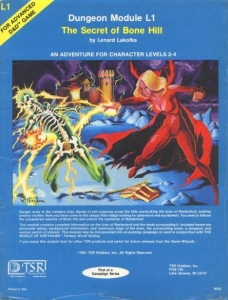
The Secret of Bone Hill is an adventure module written by Lenard Lakofka for the first edition of Advanced Dungeons & Dragons and published by TSR in 1981. It is designed for novice and intermediate players with characters of levels 2-4. The module received mixed reviews from critics.

Oriental Adventures is the title shared by two hardback rulebooks published for different versions of the Dungeons & Dragons (D&D) fantasy roleplaying game. Each version of Oriental Adventures provides rules for adapting its respective version of D&D for use in campaign settings based on the Far East, rather than the medieval Europe-setting assumed by most D&D books. Both versions of Oriental Adventures include example campaign settings.
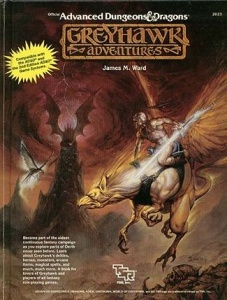
Greyhawk Adventures is an accessory for the Advanced Dungeons & Dragons (AD&D) World of Greyhawk campaign setting.

In the Dungeons & Dragons role-playing game, orcs are a primitive race of savage, bestial, barbaric humanoid.

In the Dungeons & Dragons fantasy role-playing game, the centaur is a large monstrous humanoid. Based upon the centaurs of Greek myth, a centaur in the game resembles a human with the lower body of a horse.
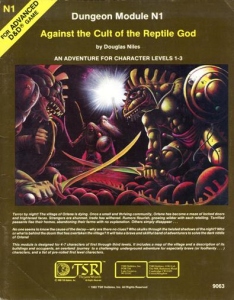
Against the Cult of the Reptile God is an adventure module for the first edition of the Advanced Dungeons & Dragons fantasy roleplaying game, set in the game's World of Greyhawk campaign setting. It is designed for novice players and gamemasters. The suggested party size is 4-7 characters of level 1-3.
Tritons are a fictional species in the Dungeons & Dragons fantasy role-playing game.
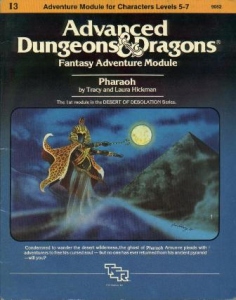
Desert of Desolation is a compilation adventure module published by TSR for the Dungeons & Dragons (D&D) fantasy roleplaying game. It combines three previously published individual modules: Pharaoh, Oasis of the White Palm, and Lost Tomb of Martek. The modules were made for use with the first edition Advanced Dungeons & Dragons (AD&D) rules. Pharaoh was created by Tracy and Laura Hickman soon after the couple married in 1977, and published by TSR in 1982. Oasis of the White Palm was a collaboration between Tracy Hickman and Philip Meyers, and Hickman wrote the Lost Tomb of Martek on his own; both were printed in 1983.

Night's Dark Terror is an adventure module for the Dungeons & Dragons (D&D) fantasy role-playing game written by British game designers Jim Bambra, Graeme Morris, and Phil Gallagher. It was designed specifically for campaigns transitioning from the D&D Basic Set to the D&D Expert Set. The player characters (PCs) journey from a farmstead into uncharted wilderness, where they encounter new hazards and contend with a secret society. The adventure received a positive review from White Dwarf magazine.

Dwellers of the Forbidden City is an adventure module, or pre-packaged adventure booklet, ready for use by Dungeon Masters in the Dungeons & Dragons (D&D) fantasy role-playing game. The adventure was first used as a module for tournament play at the 1980 Origins Game Fair, and was later published by TSR in 1981 for use with the first edition Advanced Dungeons & Dragons rules. The module was written by game designer David "Zeb" Cook, who partly ascribes his hiring by TSR to his work on this module. In the adventure, the characters are hired to find an object taken to a lost oriental-style city, which has been taken over by a cult of snake-worshipers, the yuan-ti, and their servants, the mongrelmen and tasloi.
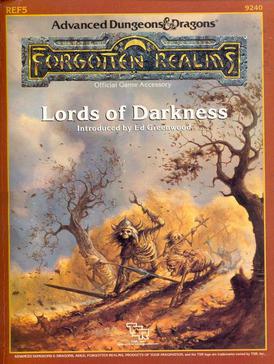
Lords of Darkness is the name of two accessories for the fictional Forgotten Realms campaign setting for the Dungeons & Dragons fantasy role-playing game.

Lankhmar – City of Adventure is an accessory for the Dungeons & Dragons fantasy role-playing game, first published by TSR in 1985.

The Book of Lairs is an accessory book for the Dungeons & Dragons fantasy role-playing game, first published by TSR in 1986. It contains an assortment of monster-themed mini-adventures. A second volume was published in 1987. TSR coded the accessories REF3 and REF4 respectively, as part of a series of similarly-coded accessories. Both volumes were received well by critics, with the second being seen more positively than the first.

Bestiary of Dragons and Giants is an accessory for the Dungeons & Dragons fantasy role-playing game, published in 1987 by TSR.

The Best of Intentions is an adventure module published in 1987 for the Dungeons & Dragons fantasy role-playing game.

The Northern Reaches is an accessory for the Dungeons & Dragons fantasy role-playing game. The book describes the land known as the Northern Reaches, which lie on the eastern seaboard of the D&D game's Known World, also known as Mystara.

The Orcs of Thar is an accessory for the Dungeons & Dragons fantasy role-playing game, written by Bruce Heard and published by TSR in 1988.
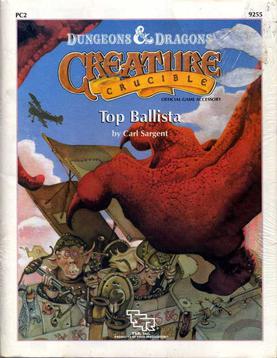
Top Ballista is an accessory for the Dungeons & Dragons fantasy role-playing game.

The AADA Road Atlas and Survival Guide was a series of supplements for GURPS and Car Wars published between 1987 and 1989 by Steve Jackson Games.

Ents of Fangorn is a supplement published by Iron Crown Enterprises in 1987 for Middle-earth Role Playing (MERP), a fantasy role-playing game based on J.R.R. Tolkien's The Lord of the Rings.